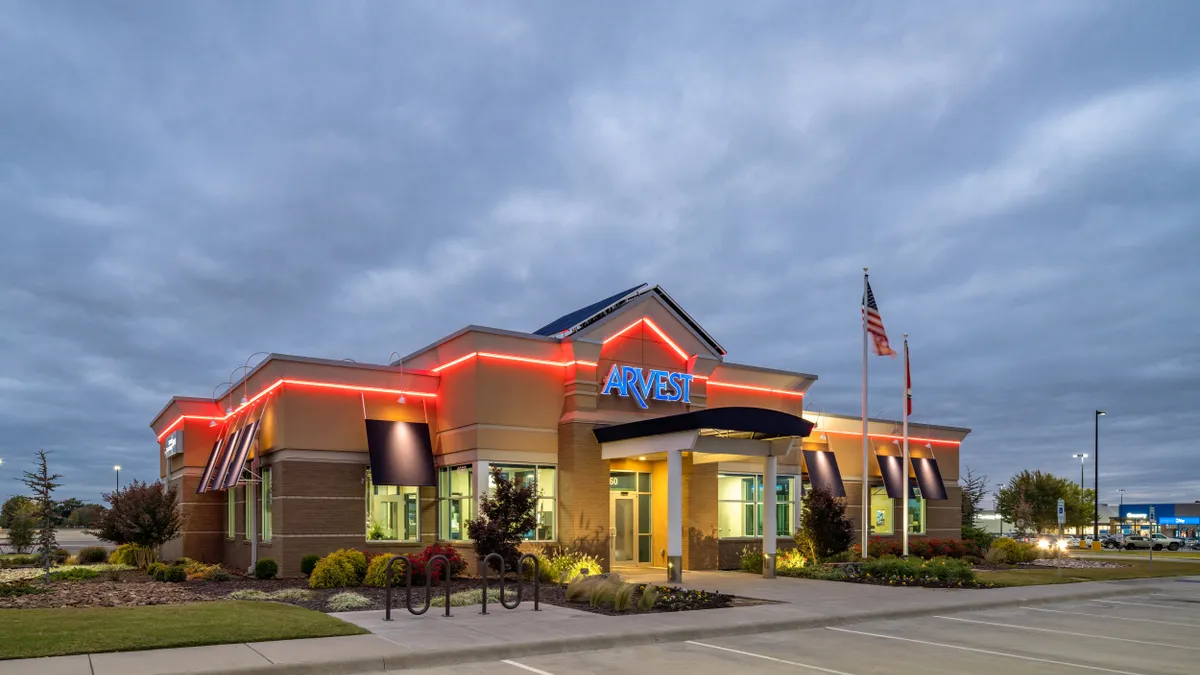In the last two years, Arvest Bank partnered with Google Cloud to kickstart a multiyear digital transformation, launched its first cloud-native payments processing platform and bolstered its tech leadership with three key appointments.
The bank recruited Chief Transformation and Operations Officer Laura Merling to lead enterprise modernization in the fall of 2021. Previously, she served as chief transformation officer at Google Cloud, chief digital officer at consulting firm Slalom, and digital strategy advisor at McKinsey.
Chief Technology Officer Ninish Ukkan joined the team in August 2022, as did Bryan Hicks, who heads product, APIs and embedded banking.

The impetus to modernize the financial enterprise swept through the industry’s largest players over the last decade, sparking digital transformation aspirations in smaller, regional banks.
“Our industry and its practices are evolving and we need to adapt to meet the future needs of our customers,” Arvest President and CEO Kevin Sabin said in Merling’s appointment announcement.
Three central tenets drove Arvest’s plans, Merling told CIO Dive. “Our transformation strategy was tied to simplification, standardization and scale.”
The first step was one of the hardest, according to Merling.
“The biggest initial challenge was I had kind of come in and made the decision wholeheartedly that we were moving to the cloud,” Merling said. “If we wanted to get scale of any kind and do it cost effectively, it was going to have to be cloud.”
Merling had C-suite support, but she needed to cultivate enterprisewide enthusiasm for change. Upskilling would be crucial, too.
“When I started here, there was no plan to move to cloud,” Merling said. “We had two data centers. One was fairly recent in terms of being built and the other had been ‘modernized’ about five years prior … we still had things on tape.”
Planning to transform
Digital transformations, like facility renovations, require planning. There are almost inevitably hiccups along the way. Some research suggests that up to half of all enterprise migrations fail to meet expectations.
Merling enlisted a third-party consulting firm to perform an end-to-end IT assessment and help architect the plan. Her team then began a series of incremental, low-impact migrations, initially punctuated by tactical pivots.
“We began with ten applications that had no significant importance to banking operations and started and stopped migrations three times because the further we got into it, the more we learned,” said Merling.
After several lift-and-shifts and a few pre-migration modernizations, the first major banking systems moved to cloud eight or nine months following the initial decision, Merling said.
The data stack needed attention as well.
“Our data was locked in silos, and when you’ve got your data stuck on the platform that runs that product, you can't see a single view of a customer,” said Merling, who rated Arvest’s initial data readiness as a two on a ten-point scale.
That score has improved substantially to seven or eight, by Merling’s estimate, spurred by broader IT enhancements that have eased data operations.
“We modernized the data stack and then, by modernizing it, we've actually been able to use it to continue to modernize our data,” Merling said.
Workforce transformation
With historically low unemployment among technologists and talent difficult to source, skills gaps remain a major obstacle to digital transformations across industries. Banks, in particular, have been plagued by a lack of sufficient cloud skills, according to Accenture research.
Merling initially leaned on Slalom to infuse digital skills into the Arvest workforce, which gained experience working side-by-side with technologists from the third-party provider.
“The initial focus was on the folks that were going to work on cloud and on data engineers,” Merling said. “We had about 15 role profiles and learning journies tied to cloud and data infrastructure.”
As migrations progressed, the bank prioritized IT talent development throughout the organization, creating a formal upskilling structure, dubbed me@arvest, to ease the transition to cloud banking.
Arvest has relationships with Coursera, LinkedIn, Google and Salesforce around training for IT, operations and marketing associates, and the bank also pays for formal certifications, Merling said.
To date, more than 1,000 Arvest technicians have been mapped to a learning journey, 300 have completed cloud fundamentals training and associates have engaged in nearly 13,000 hours of tech instruction, the company told CIO Dive.
It’s a virtuous circle. Tech transformation guides workforce development which then fuels further transformation.
As Arvest retires one of its two data centers, Merling is working in hybrid cloud while looking forward to a multicloud future.
“We are keeping one data center,” said Merling. “But our goal is to make sure we’re able to do multicloud at some point.”
The reasoning is simple, she pointed out. “It's almost cost prohibitive for a midsized bank like us to own our own data center infrastructure. I'd rather focus on spending the dollars and investment on creating differentiated customer experience and products.”















